Introduction to Basic Logic Gates with Truth Tables
I never thought I’d spend a Saturday morning hunched over circuit diagrams, but trying to figure out how computers think pulls you in like a puzzle you can’t resist. After hours of tinkering with logic gates, the building blocks of digital electronics, I’ve put together this guide to share what I’ve learned. It’s a deep dive into basic logic gates and their truth tables, now beefed up with advanced concepts like De Morgan’s Theorem and gate conversions, all explained in a way that’s clear whether you’re a student, a hobbyist, or just curious about what makes your devices tick. This tutorial covers everything from what these gates are to how they’re used in the real world, with a friendly tone and practical examples to bring it all to life. Let’s get started.
What Are Logic Gates?

Logic gates are the foundation of every digital circuit and computer system. Imagine them as the alphabet of electronics simple pieces that combine to form the complex systems running your phone or laptop. They process signals that are either on or off, true or false, represented as 1 or 0. This binary system is the heart of digital computing. Each gate takes one or more inputs, applies a specific logical rule, and produces a single output. In modern electronics, these gates are built using tiny transistors and diodes, often with technologies like CMOS or MOSFETs, which are types of electronic switches. You’ll find them in microprocessors, microcontrollers, and countless DIY electronics projects.
When I first took an electronics class, my professor said something that stuck with me: if you understand logic gates, you understand how computers make decisions. It’s true. Computers use binary digits 1s and 0s instead of the decimal numbers we’re used to, and these gates handle all the logical operations. There are seven basic logic gates: AND, OR, NOT, NAND, NOR, XOR, and XNOR. These gates are the core of digital integrated circuits, or ICs, and are used everywhere, from simple circuits with a few gates to microprocessors with millions. They can even be built with diodes, transistors, or less common things like relays or optics, which makes them incredibly versatile for all sorts of electronic designs.
To set the stage, let’s talk about binary and decimal numbers. We use decimal numbers 0 through 9 every day, but computers rely on binary, just 0 and 1, because it matches the on-off nature of electronic switches. A 1 represents a high voltage or signal, while a 0 means low or no signal. This binary system ties into Boolean algebra, a kind of math developed by George Boole, which we’ll explore next to understand how gates work.
Understanding Binary Logic and Boolean Algebra

Before we jump into the gates themselves, let’s look at the math behind them. Boolean algebra, named after George Boole, is a simple form of algebra where every value is either true (1) or false (0). It’s perfect for digital circuits because it matches their on-off behavior. In Boolean algebra, a 1 stands for a true state or high voltage, and a 0 stands for false or low voltage. The operations are straightforward: AND acts like multiplication, OR like addition, and NOT flips the value, like a negative sign. When I first learned this, I thought of it as algebra stripped down to just two numbers, which makes digital systems so reliable there’s no gray area, just clear 1s and 0s.
This Boolean logic lets us describe what logic gates do mathematically. For example, voltage signals in circuits are measured relative to ground, where no voltage is a 0 and full voltage is a 1. Logic gates are like specialized amplifiers designed to handle these binary signals, turning inputs into predictable outputs based on their rules. Understanding this foundation makes the gates themselves much easier to grasp.
The Seven Logic Gates with Symbols and Truth Tables
There are seven basic logic gates that power all digital systems. Each has a unique job, a specific symbol, a mathematical rule called a Boolean expression, and a truth table showing how inputs produce outputs. Most gates take two or more inputs, except for one, and their truth tables list every possible input combination. Let’s go through each gate, with its symbol, rule, truth table, and a real-world analogy to make it relatable. I’ll also include the mathematical expressions and explain how they work.
AND Gate
The AND gate is like a strict judge it only says yes, or outputs a 1, when every single input is a 1. If even one input is a 0, the output is 0. Picture it as a series circuit with two switches: the light only turns on if both switches are flipped on. The symbol for an AND gate is a D-shaped figure, flat on the left where inputs enter and curved on the right where the output comes out. Mathematically, it’s written as A · B, or sometimes just AB, meaning both A and B must be true for the output to be true.
The truth table for a two-input AND gate shows this clearly: when inputs A and B are both 0, the output is 0; when A is 0 and B is 1, or vice versa, the output is still 0; only when both are 1 does the output become 1. This gate is used in systems where multiple conditions must be met, like a security system that needs both a keycard and a PIN to unlock a door.
Truth Table for 2-Input AND Gate:
| Input A | Input B | Output |
| 0 | 0 | 0 |
| 0 | 1 | 0 |
| 1 | 0 | 0 |
| 1 | 1 | 1 |
OR Gate
The OR gate is more forgiving it says yes, or outputs a 1, if at least one input is a 1. It only outputs a 0 if all inputs are 0. Think of it as a parallel circuit: if either switch is on, the light glows. Its symbol looks like a shield, curved on the left for inputs and pointed on the right for output. The Boolean expression is A + B, meaning the output is true if A or B or both are true.
The truth table for a two-input OR gate shows that the output is 0 only when both A and B are 0; otherwise, it’s 1. This gate is handy in systems where any one condition can trigger an action, like a car’s warning light that activates if either the door is open or the seatbelt is unbuckled.
Truth Table for 2-Input OR Gate:
| Input A | Input B | Output |
| 0 | 0 | 0 |
| 0 | 1 | 1 |
| 1 | 0 | 1 |
| 1 | 1 | 1 |
NOT Gate
The NOT gate is the rebel it takes one input and flips it. If you give it a 1, it outputs a 0; give it a 0, it outputs a 1. It’s like a light switch that’s normally on but turns off when you press it. The symbol is a triangle with a small circle, called a bubble, at the output to show inversion. Mathematically, it’s written as Ā or A’, meaning “not A.”
The truth table is simple: input 0 gives output 1, and input 1 gives output 0. This gate is crucial for building other gates like NAND and NOR and is used in circuits to reverse signals, like turning off an LED when a button is pressed.
Truth Table for NOT Gate:
| Input | Output |
| 0 | 1 |
| 1 | 0 |
NAND Gate
The NAND gate, short for NOT-AND, combines an AND gate with a NOT gate. It outputs the opposite of an AND gate: it gives a 0 only when all inputs are 1, and a 1 otherwise. Imagine a system where a machine stops only if all sensors detect a problem. The symbol is an AND gate with a bubble at the output. The Boolean expression is (A · B)’, meaning the AND result is inverted.
The truth table shows that with inputs 00, 01, or 10, the output is 1; only with 11 is it 0. I once built an alarm system using NAND gates alone, amazed at how versatile they are. This gate is used in circuits where you need a signal unless all conditions are met, like a safety override.
Truth Table for 2-Input NAND Gate:
| Input A | Input B | Output |
| 0 | 0 | 1 |
| 0 | 1 | 1 |
| 1 | 0 | 1 |
| 1 | 1 | 0 |
NOR Gate
The NOR gate, or NOT-OR, is an OR gate followed by a NOT gate. It outputs a 1 only when all inputs are 0; any 1 input gives a 0 output. Think of a system that activates only if no conditions are met, like a standby mode. The symbol is an OR gate with a bubble at the output. The Boolean expression is (A + B)’, meaning the OR result is inverted.
The truth table shows a 1 output only for inputs 00; inputs 01, 10, or 11 give 0. NOR gates are used in circuits like memory latches, where you need a signal only when nothing is active.
Truth Table for 2-Input NOR Gate:
| Input A | Input B | Output |
| 0 | 0 | 1 |
| 0 | 1 | 0 |
| 1 | 0 | 0 |
| 1 | 1 | 0 |
XOR Gate
The XOR gate, or Exclusive OR, outputs a 1 when an odd number of inputs are 1. For two inputs, it’s 1 when they’re different, 0 when they’re the same. It’s like a hallway light with two switches: flipping either one changes the light’s state, but flipping both cancels out. The symbol is an OR gate with an extra curved line on the input side. The Boolean expression is A ⊕ B, or A’B + AB’, meaning one input is true but not both.
The truth table shows 0 for inputs 00 and 11, and 1 for 01 and 10. XOR gates are used in arithmetic circuits, like adders in CPUs, to compare or combine signals.
Truth Table for 2-Input XOR Gate:
| Input A | Input B | Output |
| 0 | 0 | 0 |
| 0 | 1 | 1 |
| 1 | 0 | 1 |
| 1 | 1 | 0 |
XNOR Gate
The XNOR gate, or Exclusive NOR, is the opposite of XOR. It outputs a 1 when inputs are the same, 0 when different. Imagine a system that checks if two signals match, like a password verifier. The symbol is an XOR gate with a bubble at the output. The Boolean expression is (A ⊕ B)’, or A’B’ + AB, meaning both inputs are the same.
The truth table shows 1 for inputs 00 and 11, and 0 for 01 and 10. XNOR gates are used in circuits that detect equality, like in digital comparators.
Truth Table for 2-Input XNOR Gate:
| Input A | Input B | Output |
| 0 | 0 | 1 |
| 0 | 1 | 0 |
| 1 | 0 | 0 |
| 1 | 1 | 1 |
How to Read Truth Tables
Truth tables are like cheat sheets for logic gates they show exactly what output you get for every possible input combination. Each row represents one set of inputs, with the left columns showing the input values and the right column showing the output. For a gate with two inputs, there are four rows because there are four possible combinations: 00, 01, 10, and 11. For one input, like the NOT gate, there are two rows. For three inputs, you’d have eight rows, since the number of rows is always 2 raised to the number of inputs.
When I started, I found truth tables like solving a logic puzzle. You can trace the signal through a gate and predict the outcome. To make it fun, try an online simulator where you can click inputs and see the output change instantly. It’s a great way to see the gates in action without wiring anything up.
De Morgan’s Theorem
To deepen our understanding, let’s explore De Morgan’s Theorem, a powerful tool in Boolean algebra that simplifies circuits. The first theorem says that a NAND gate is the same as an OR gate with inverted inputs: the output of NOT (A AND B) equals NOT A OR NOT B, written as (A · B)’ = A’ + B’. The second theorem says a NOR gate is like an AND gate with inverted inputs: the output of NOT (A OR B) equals NOT A AND NOT B, or (A + B)’ = A’ · B’.
These rules are game-changers for circuit design. For example, I once redesigned a circuit using De Morgan’s and cut the number of gates in half, saving space and cost. It’s like finding a shortcut in a maze you get the same result with less work.
Converting Gates
Logic gates are flexible you can build any gate from others, especially using NAND or NOR, which are called universal gates. This is handy when you’re short on components. Let’s see how to make one gate from another, complete with the math and truth tables.
To make a NAND gate, you combine an AND gate with a NOT gate. The output is the inverse of AND: high unless both inputs are high. Mathematically, it’s Y = (A · B)’. The truth table confirms this: inputs 00, 01, and 10 give output 1; 11 gives 0. A diagram would show an AND gate feeding into a NOT gate.
For a NOR gate, you take an OR gate and follow it with a NOT gate. The output is high only when both inputs are low. The expression is Y = (A + B)’. The truth table shows 1 for 00, and 0 for 01, 10, and 11. Picture an OR gate connected to a NOT gate.
An EX-OR gate is trickier, built from NOT, AND, and OR gates. It outputs high when inputs differ, expressed as Y = A’B + AB’ or A ⊕ B. The truth table gives 0 for 00 and 11, 1 for 01 and 10. A diagram shows inputs feeding into inverters, then AND gates, then an OR gate.
The EX-NOR gate is an EX-OR followed by a NOT gate, outputting high when inputs are the same. Its expression is Y = (A’B + AB’)’, or A’B’ + AB. The truth table shows 1 for 00 and 11, 0 for 01 and 10. The diagram adds a NOT gate to the EX-OR setup.
These conversions show how versatile gates are you can create any logic function with the right combination, especially using universal gates.
Universal Gates: NAND and NOR

NAND and NOR gates are special because they’re universal you can build any logical function using just one type, either NAND or NOR. This makes them incredibly valuable in circuit design because they’re simple and cheap to manufacture in integrated circuits.
Why are they universal? They can mimic the three core operations: AND, OR, and NOT. With these, you can build anything. For example, to make a NOT gate with a NAND gate, you connect both inputs together. If the input is A, the output is (A · A)’ = A’, or NOT A. A diagram would show a single NAND gate with tied inputs.
To make an AND gate using NAND, you take a NAND gate and follow it with a NOT gate (made from another NAND with tied inputs). The result reverses the NAND’s inversion, giving A · B. For an OR gate, you invert each input using NAND-based NOT gates, then feed them into another NAND: (A’ · B’)’ = A + B. NOR and EX-OR gates follow similar logic, combining multiple NANDs in specific patterns.
Using NOR gates works the same way. A NOT gate is a NOR with both inputs tied: (A + A)’ = A’. An OR gate is a NOR followed by a NOR-based NOT gate. For an AND gate, invert inputs with NOR-based NOTs, then use a NOR: (A’ + B’)’ = A · B. NAND and EX-NOR gates are built with more NORs in a cascading setup.
I once built a circuit using only NAND gates because I ran out of other ICs. It was a challenge, but working through the Boolean logic to get the right output taught me how powerful these universal gates are.
Uses of Logic Gates in the Real World

Logic gates are everywhere, powering the devices we use daily. Their behavior, defined by truth tables, determines how they’re applied. In computers, they form the backbone of CPUs, which contain billions of gates. For example, arithmetic operations like addition rely on circuits called adders, made from XOR and AND gates. Memory storage uses flip-flops, built from NAND or NOR gates, to store bits. Every click or keystroke on your laptop goes through logic gates to process the input.
In consumer electronics, gates are just as critical. Your TV remote uses them to encode button presses into signals. Digital cameras process image data with logic circuits. Gaming consoles rely on gates for everything from reading controller inputs to rendering graphics on the screen. I built a simple LED display circuit once, and seeing the gates control each light was a thrill.
Security systems make clever use of gates. An alarm might use an AND gate to trigger only when multiple sensors like a door and motion detector are active. Password systems use XOR gates to compare your input to a stored code, ensuring they match. Keypad locks combine gates to check if the right button sequence is pressed, like in a bank vault.
In cars, logic gates are vital. Anti-lock braking systems process sensor data with gates to prevent wheel lockup. Engine control units use complex gate arrays to optimize fuel and timing. Dashboard lights, like low-fuel warnings, activate based on gate logic when conditions are met, such as low fuel and engine on.
Beyond these, gates are used in smart home devices, like an IoT system that turns on lights only when it’s dark and motion is detected, using an AND gate. In AI hardware, gates form neural network circuits for fast computations. There’s no limit to how many gates you can combine, though physical space in a chip sets practical boundaries. As chip technology improves, we pack more gates into smaller spaces, making devices faster and more powerful.
How Logic Gates Work Physically
To really get logic gates, you need to know how they work at the hardware level. They’re built from transistors inside integrated circuits, or ICs. There are two main technologies: TTL, or Transistor-Transistor Logic, which uses bipolar transistors for fast switching but consumes more power, typically at 5 volts; and CMOS, or Complementary Metal-Oxide-Semiconductor, which uses field-effect transistors for lower power use and can work at various voltages, like 3.3 or 5 volts. CMOS is more common today because it’s energy-efficient.
Inside a chip, transistors act like tiny switches, either on or off, matching the 1 and 0 of binary logic. For example, in a CMOS AND gate, when both inputs are high, the transistors create a path to the output, giving a 1. If either input is low, the path breaks, outputting 0. This clear on-off behavior makes digital circuits reliable, unlike analog circuits where signals can vary. In diagrams, we often skip showing power connections to keep things simple, but gates need a voltage supply to work.
Advantages and Challenges of Logic Gates

Logic gates are amazing but not perfect. They’re reliable because digital signals resist noise unlike analog signals, which can pick up interference. Their outputs are predictable, making complex systems consistent. You can combine them endlessly to build anything from a calculator to a supercomputer, and they follow standard designs for easy integration. Modern CMOS gates use very little power when idle, which is why your phone battery lasts.
But there are challenges. Gates take a tiny fraction of a second to respond, called propagation delay, which can limit speed in fast circuits. They use more power when switching states, and in dense chips, this generates heat. They’re not great for analog signals without extra conversion. In extreme environments, like space, radiation can flip bits, causing errors. I once worked on a high-speed project where we had to tweak the design to account for delays, a real lesson in planning.
Experimenting with Logic Gates

The best way to understand gates is to play with them. You can try breadboard experiments using ICs like the 7400 series, which includes NAND gates. Wire up switches, LEDs, and gates to see truth tables come to life flip a switch and watch the LED change. Digital logic simulators, like Logisim or CircuitVerse, let you build virtual circuits without hardware, perfect for testing complex ideas. Microcontrollers like Arduino can mimic gate logic in code, letting you connect real inputs and outputs. For advanced learning, Field-Programmable Gate Arrays, or FPGAs, let you program hardware circuits, which is like sculpting logic in silicon.
My first breadboard circuit was a simple AND gate setup. When the LED lit up exactly as the truth table predicted, it felt like cracking a code. Try building a half-adder with XOR and AND gates it’s a great way to see arithmetic in action.
Common Questions About Logic Gates
People often ask how digital circuits differ from analog ones. Digital circuits use discrete values 0 and 1 while analog handles continuous signals, like sound waves. Logic gates power digital systems. Another question is why NAND and NOR are universal. It’s because you can build any logic function with just one of them, making them super versatile. A modern CPU, like Apple’s M1, has billions of gates, formed from transistors working together. Gates can fail from physical damage, overheating, voltage spikes, or even radiation in space. To troubleshoot a circuit, check power, test inputs with a logic probe, inspect connections, and swap out suspect chips. De Morgan’s Theorem, as mentioned earlier, transforms NAND and NOR expressions for simpler designs. Gates in CPUs form arithmetic units, memory, and control logic, enabling everything from math to program flow. The easiest way to learn gates is to remember their core rules: AND needs all inputs high, OR needs one, XOR needs one but not both, and so on.
Wrapping Up
Logic gates are the unsung heroes of digital electronics, turning simple binary signals into the complex systems we rely on every day. From the straightforward NOT gate to the versatile NAND and NOR, these components, along with concepts like De Morgan’s Theorem and gate conversions, let us build everything from calculators to AI processors. Understanding their truth tables and uses gives you a peek into how computers make decisions.
This guide, now packed with deeper explanations and practical insights, should give you a solid foundation. Whether you’re studying, building a project, or just curious, these concepts are your starting point. Grab our free PDF cheat sheet with truth tables and diagrams by signing up below. If you’ve got questions or stories about your own gate experiments, share them in the comments I’d love to hear about your adventures in electronics. Happy tinkering!
FAQ
What is the difference between digital and analog circuits?
Digital circuits process discrete values (typically just 0 and 1), while analog circuits process continuous values. Logic gates are the building blocks of digital circuits.
Why are NAND and NOR gates called universal gates?
They’re called universal because any logical function can be implemented using only NAND gates or only NOR gates. This makes them extremely versatile in circuit design.
How many logic gates are in a modern CPU?
Modern CPUs contain billions of logic gates. For example, Apple’s M1 chip has approximately 16 billion transistors, which form various types of logic gates and other components.
Can logic gates fail? How?
Yes, they can fail due to:
- Physical damage to the IC
- Overheating
- Voltage spikes
- Manufacturing defects
- Age-related degradation
- Radiation-induced errors (in space or nuclear environments)
How do I troubleshoot logic gate circuits?
- Verify power connections
- Check input signals with a logic probe or multimeter
- Test each gate individually if possible
- Look for shorts or open connections
- Replace suspected faulty ICs
- Use an oscilloscope for timing issues

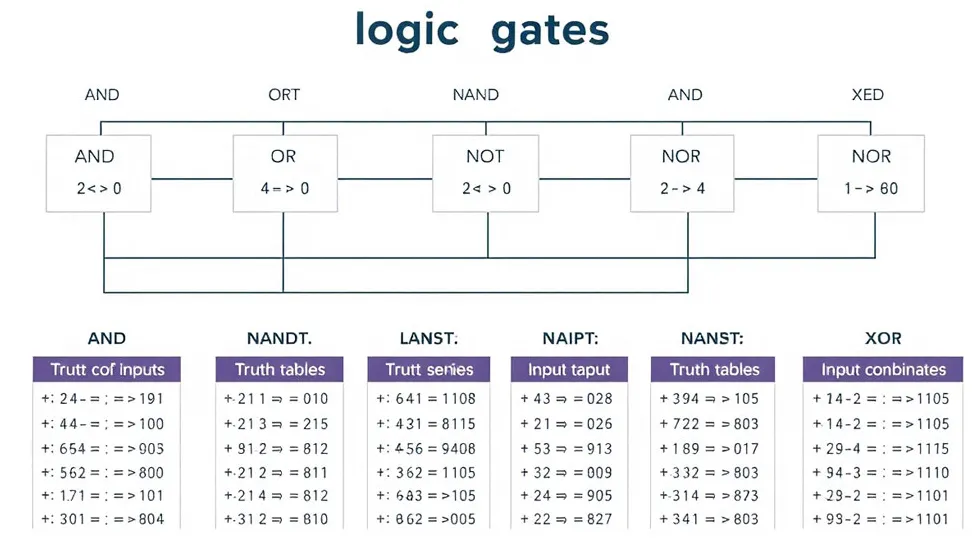
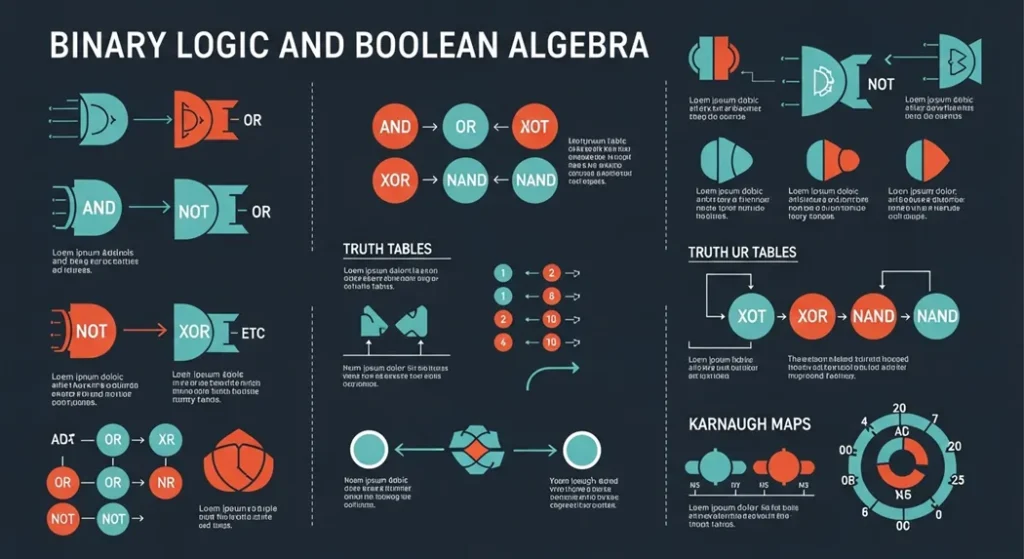
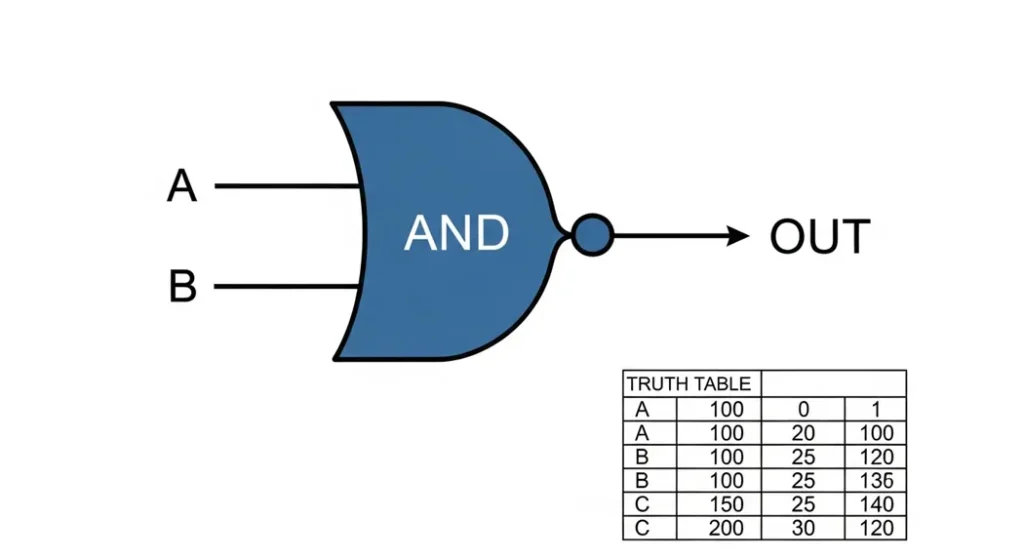
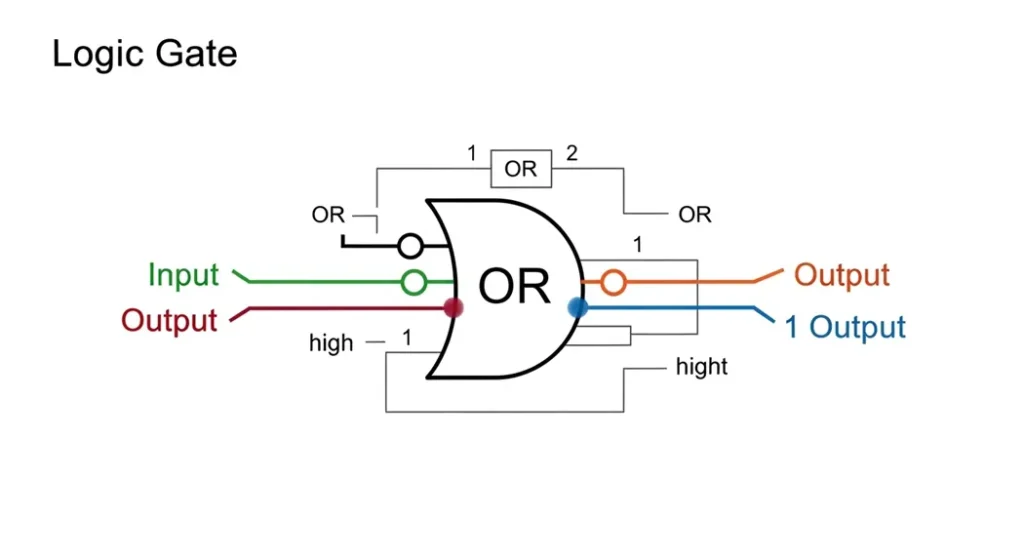
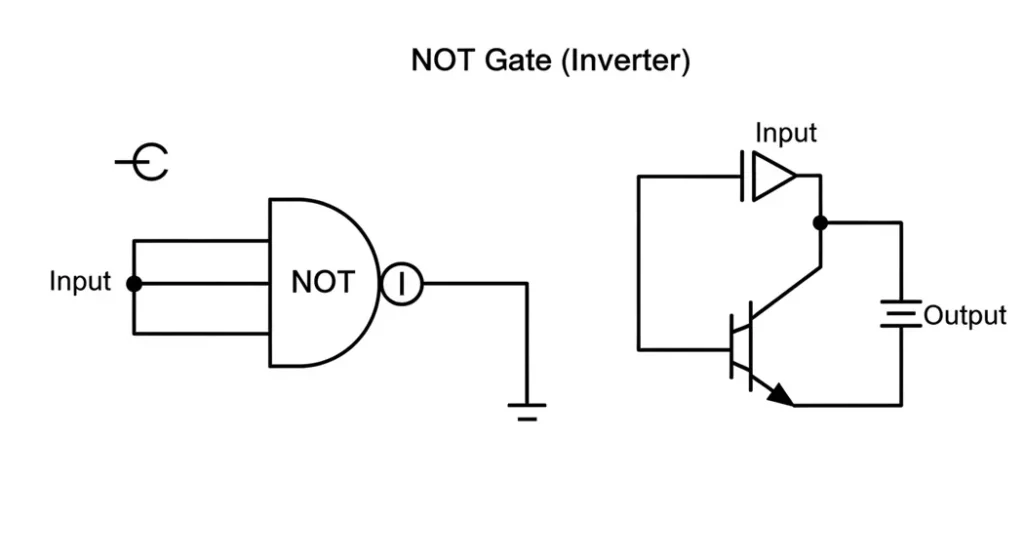

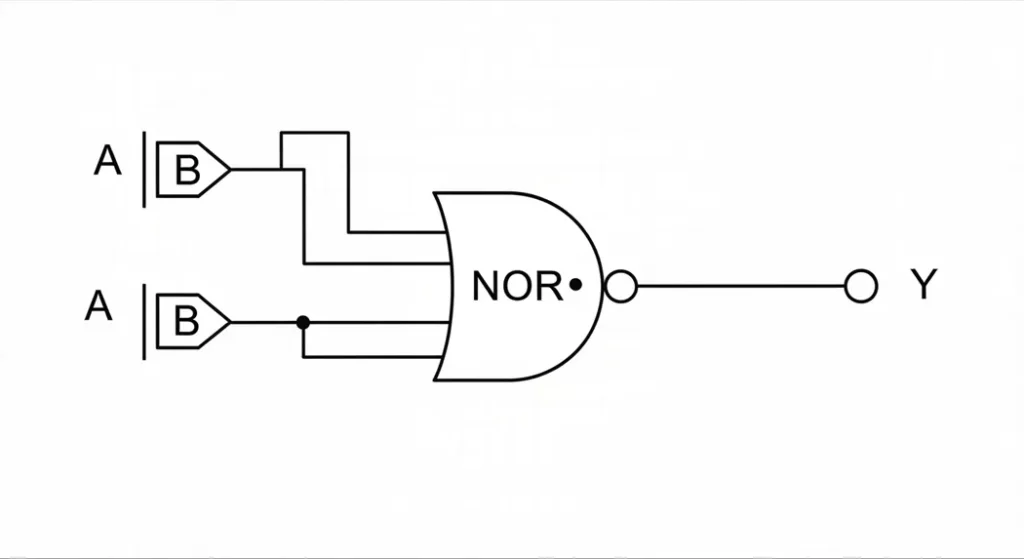
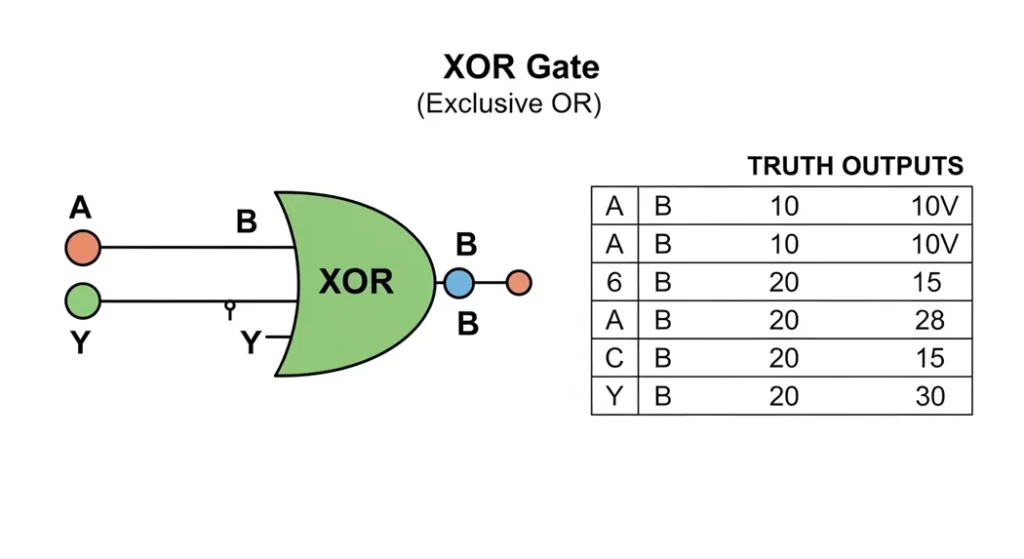
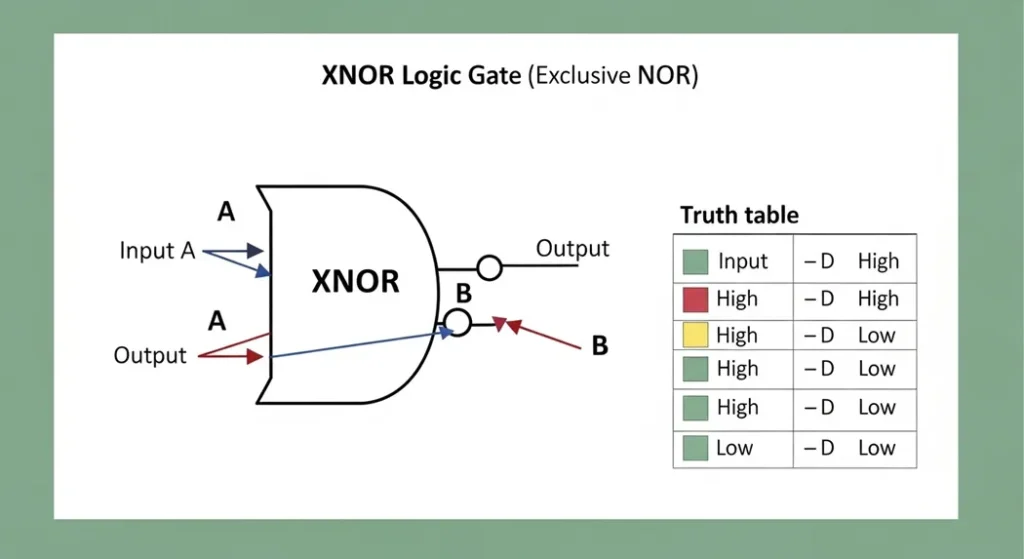
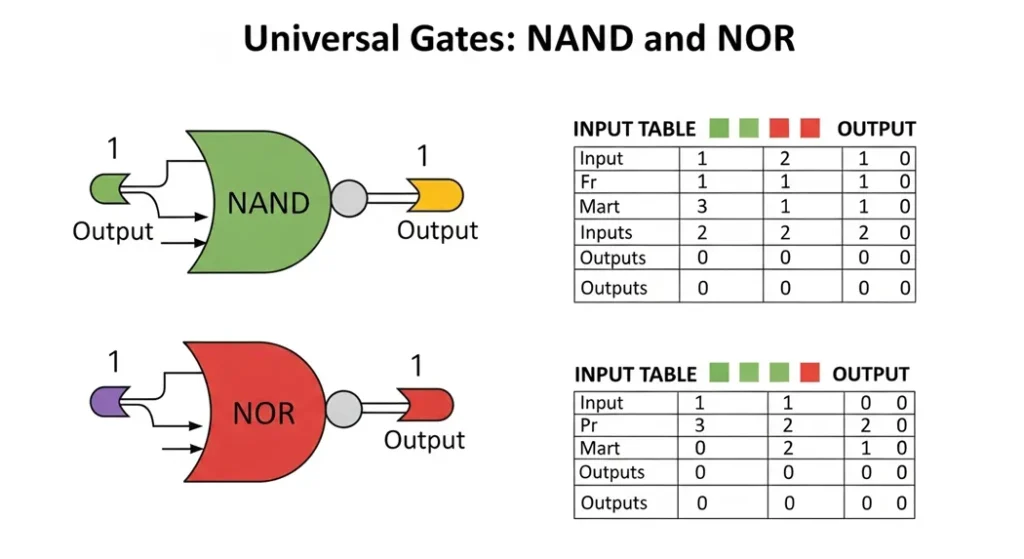
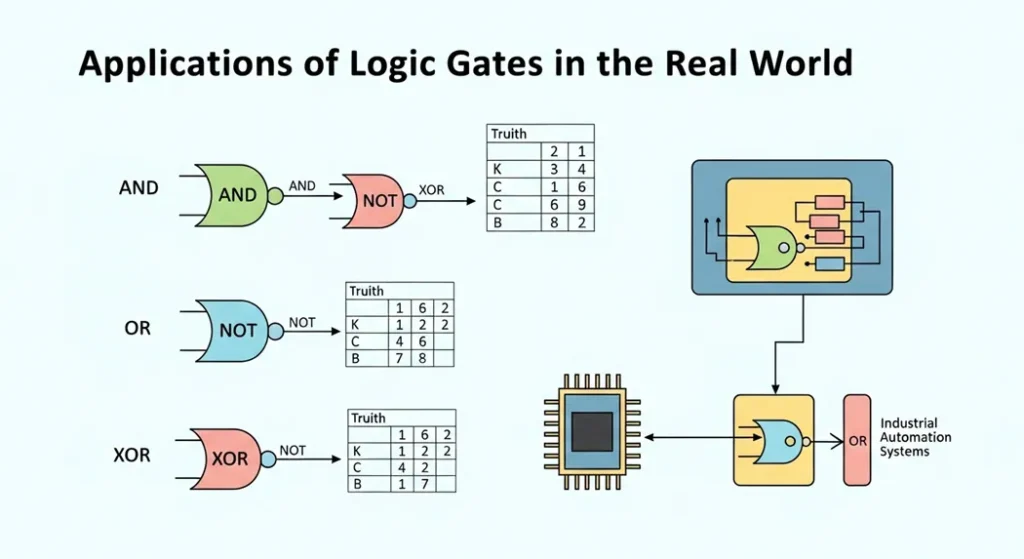
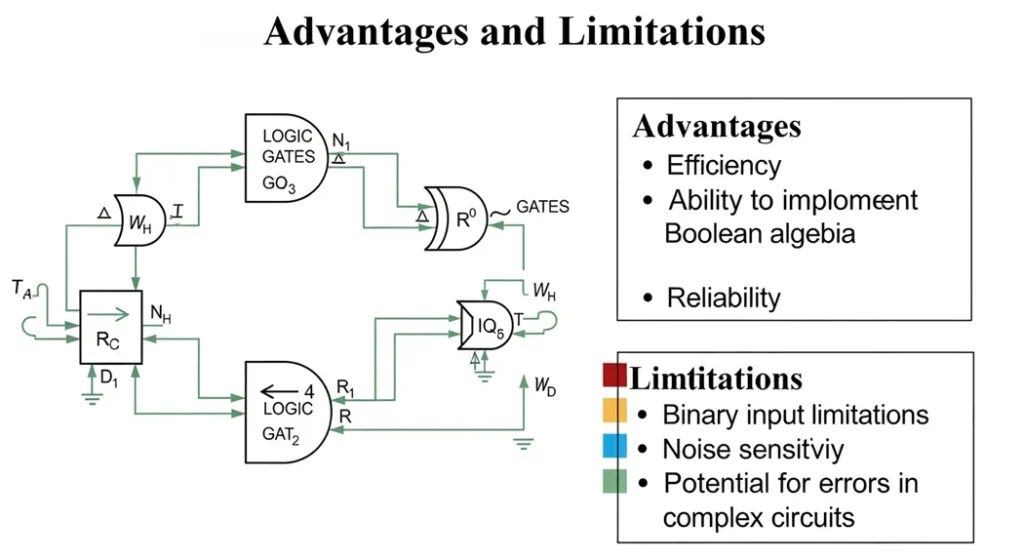
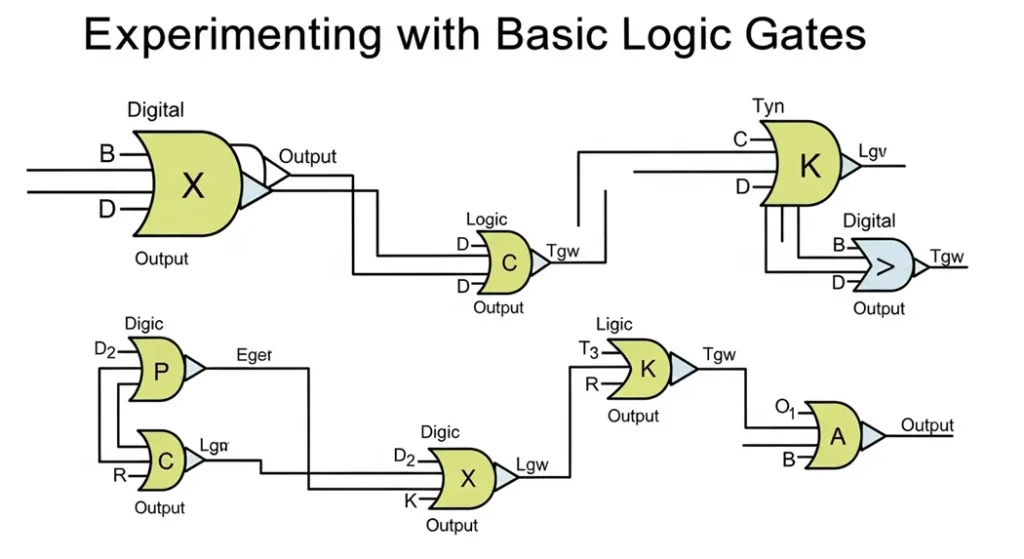
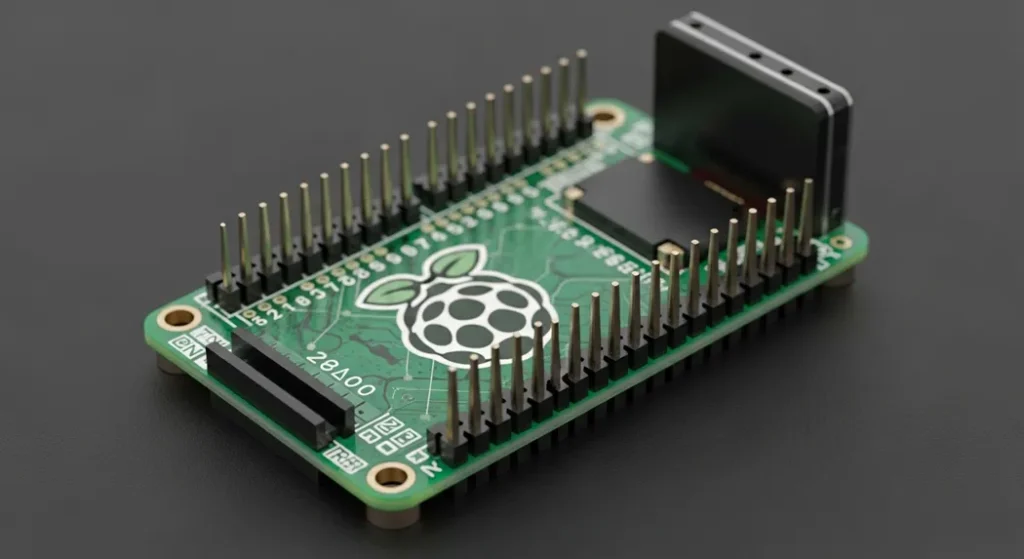
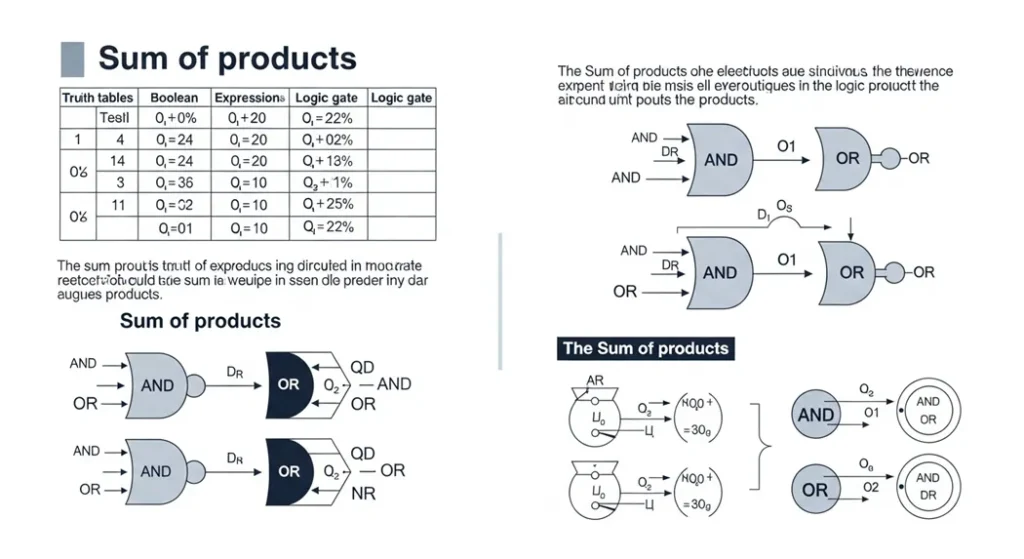
Pingback: The Ultimate Comparison: ESP32 vs Raspberry Pi /